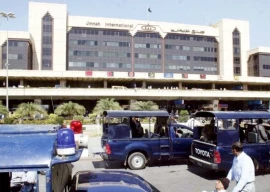
Dar has been leading the case from the side of local filmmakers in Lahore, who have vociferously opposed the idea of Indian films and content since Partition in 1947. “The state has never supported the industry, it actually ruined it, but that’s another story. Everything was led on private initiative,” recalls Dar, who entered the industry as an assistant in 1951 while he was still in his early twenties and eventually went on to become a leading director. He says that the issue of Indian films had initially started out as a question of getting equal access to larger markets. But today, it is a question of patriotism. “This is about seeing this out to the end. So until we [get an] answer what exactly the state’s position is on this; the court’s ruling in our favour or not is not the issue. This is not just a matter of concern for the film industry, it is connected to the broader idea of the nation,” he says.

Santosh Kumar, Syed Shaukhat Hussain Rizvi and Syed Sibtain Fazli during the Jaal movement in 1954. SOURCE: AHMED SIBTAIN FAZLI
Over the last few months, the debate surrounding the role of Indian content has heated up following the ruling of the Lahore High Court. Last month, the law regulating the import of Indian content was suspended in hopes to clarify the position on the import of Indian films. The build-up in recent weeks even included Bilawal Bhutto asking whether the country has become ‘Banistan’ due to the tendency of banning things we cannot deal with.
In 2006, Shaukhat Aziz decided to ease the regulations that had banned Indian films from being screened in Pakistan after the 1965 war. Since then, local directors and producers such as Syed Noor, Aslam Dar, and Chaudhry Kamran have been at the forefront of the struggle to ban Indian films in the interest of the local film industry. To understand why the opposition to Indian films has lasted so long, it is critical to know the context in which the film industry from Lahore would shape itself from the earlier years.
New country, new drama
Roughly 144 films were released on this side of the border the year before Partition. The new industry always shared an uneasy tension with the cinema houses that were demanding more content. It is well known that importing Indian films had kept the cinema houses alive, while new filmmakers, who generally had migrated from the old industry, were struggling find a firm footing in this smaller new setting. “When Partition occurred, the [filmmakers] felt they should probably go to Pakistan where there will be the advantage of citizenship, would be treated like first-class citizens and would be able to make good films. So almost all of the leading people came to Pakistan,” says Ahmed Sibtain Fazli, a lawyer and son of Syed Sibtain Fazli, one of the pioneer filmmakers during the early 1950s. The prominent filmmakers and actors who had moved to Pakistan included Shaukhat Hussain Rizvi, Madame Noor Jehan, WZ Ahmed, AR Kardar, and Mehboob Khan.

“When they arrived they realised that the infrastructure was still very nascent in Pakistan. Mehboob saheb would say, ‘ I wonder how films can be made in a country where there is a shortage of electricity,’” recalls Fazli. Mehboob Khan and AR Kardar ended up returning to India after seeing the dire circumstances, but local filmmakers, who had been alienated by the elite class’s negative opinion of artists and lacked state support, were keen to carve out a new identity for themselves.

The tension between distributors and filmmakers was prevalent from the very beginning. In his book on Pakistani cinema, Mushtaq Gazdar quotes the legendary filmmaker WZ Ahmed implying that the struggle was imminent. According to Ahmed, three local producers and twelve distributors of Indian films met government officials in the first of the meetings. The producers had pushed for a five-year ban so that local cinema could grow. Ahmed also claims that the distributor lobby, seeing fears about Indian films being banned, approached the then federal minister of industry, Sardar Abdur Rab Nishtar, telling him that thousands of jobs would be lost. As a result, the government refused to ban the Indian films.
When Nishtar became the minister, the government issued a notification saying that Muslims should not get involved with filmmaking and that it was best for the infidels to be left with the job. Regardless, the undertone surrounding the ‘new Muslim’ filmmakers was that they had no genuine place in society.

By 1952, an important agreement was put in place that would allow for the exchange of films between India and Pakistan. The producers generally viewed it as a loophole that had encouraged Indian content, since it was rare for Pakistani films to be screened in India. Sibtain Fazli produced Dupatta, which allegedly sparked sectarian riots in India the same year. The event would have an important impact on local filmmakers, whose own view was becoming increasingly driven by the idea that India wanted Pakistani films to fail in both local and international markets.
The film’s controversy further intensified the movement against Indian films, which was primarily based in Lahore. The position as explained by Sibtain Fazli’s other son, Ali Sibtain Fazli, was against the quota system allowing 10 films from both sides. In fact, the position of the producers given to the government at the time was that they should either open the border completely for equal access to both markets or completely ban Indian films.

“Let it be open trade for both sides because then we get the Indian market. This is essentially the basis of what became to be known as the Jaal movement,” remarks Ali. Producers, studio-owners, actors and technicians joined in the protest to stop the Indian film Jaal from screening, which had been given permission to be screened only in East Pakistan but was brought to West Pakistan by Bari Malik. The protest ended in an agreement to allow Indian films to come to Pakistan on a film-to-film basis for both East and West Pakistan.
The protest, one of the major agitations by the industry, was led by WZ Ahmed, then head of the producers association, actor Santosh Kumar, director Shaukhat Hussain Rizvi and Sibtain Fazli. It also included several screen stars, such as Madame Noor Jahan, Naina, Sudhir and others. “I have this picture of Santosh Kumar, my father, and Shaukhat Rizvi, all in handcuffs. They were arrested and put behind bars during the protest. Before nationalism, it was economics that was driving the movement,” recalls Ali.

The state before the Ayub Khan era never brought forth a firm policy on Indian films and cinema. There was an understanding that film could be used as a political tool, but until then the state had relied specifically on the censor board, which was more vigilant against the communist threat than the question of Indian films. The Jaal movement managed to consolidate the local filmmakers association into a broader collective identity. After that there was a boom and the industry saw a massive increase in production. But the stigma surrounding Indian films and its influence was never out of the shadows.
The build up to the 1965 decision of banning Indian cinema, was accompanied by a series of attempts by the state to encroach on the space of local industry, in terms of artistic autonomy, whether through censorship or government incentives. The government first decertified the screening of Indian films under the ambit of the Censorship of Films Act enacted in 1963 for the betterment of the local industry and then eventually banned them as a part of state policy in 1965. The producers had gained their objective and, due to national furor, it was difficult for the exhibitors and distributors to contest the ban.

On the other hand, the 1965 curbs opened the door to a thriving black-market and the trend of copying gained momentum. Local filmmakers, pinched with the requirements of producing more films, were compelled to plagiarise and copy the big-budget films that were being made in India.
“It was a lottery for the Pakistani film industry at the time. We had some real talent like Shaukhat Hussain Rizvi and his father, but it also gave opportunities to new assistant directors who were not so focused on producing original work,” says Mehfooz Chaudhry, owner of the now closed Ratan cinema and leading exhibitor and filmmaker. His father, Chaudhry Eid Muhammed, who had received the cinema through land-allocation, was also a leading distributor and exhibitor who imported Indian films until the 1965 ban. Mehfooz fought a related case in 2008, asking the government to clarify its position on Indian films, since his father’s imported films Jhansi Ki Rani, Awara, Barsat and Bharat, had been suspended following the government ban in 1965. However, there was little conclusion to the debate surrounding Indian films.
“It was impossible for the public to go to India at the time, but those with the right connections would go there and copy these films on tape. It wasn’t a question of who was doing it but of who wasn’t doing it,” adds Chaudhry. He implied that the famed film Armaan starring Waheed Murad, was also a copy of the Indian film Dil Tera Deewana.
During the 1960s, Kabul became a frequently visited spot where many filmmakers would spend their weekends watching Indian films playing in cinemas and taking notes. The local screenwriters would then forge scripts for their Pakistani version. The situation became even more interesting as the signal from the television station in Amritsar, which screened Indian films, exposed the plagiarism of the Pakistani film industry in 1973.
Dar recalls that by then the industry had developed a battered reputation due to the plagiarism and another battle had sprung up regarding banning of pirated tapes. In 1977, the producers pushed the government to stop the influx of Indian tapes, but the movement had little impact on the new government. The piracy question would never be addressed by the state.
However, during the Zia regime, the regulations on Indian cinema increased significantly with the ensuing Motion Pictures Act of 1979 and then the Film Rules Act of 1980. The latter would explicitly refer to control of Indian content for the first time. The Islamisation era that promoted the idea of an Islamic culture also intensified the nationalist parameters of the debate for the public. For local filmmakers, on the other hand, the issue remained the same — that the industry must be protected.
A game without rules
The tug of war ensued for the next two decades until the decision by Shaukat Aziz to ease the regulations on Indian films in 2006. The decision had less to do with the India-Pakistan relationship and more with economic viability, and the added fact that the government could not regulate piracy in the country.
Last year, the Pakistan Peoples Party government also attempted to form a national framework for Pakistani cinema, which was ironically based on the BJP’s Shining Indian model. To make matters worse, the initiative tried to use the half-baked plan of implementing it through the censor board, rather than developing a concrete apparatus to deal with the industry.
So far, the current government has not laid out a concrete strategy to help the industry either, but is generally believed to accept the import of Indian films.
Filmmaker Shahzad Nawaz feels that this attitude of apathy towards the industry is changing with a building consensus that film should be used as a form of soft power for the country. Hence, some form of clarity regarding the overall status of the industry is extremely important.
“We are at a critical period in which a film renaissance is taking place, but the issue is that we have nowhere to go to address our complaints. I think that we are reaching the point, like in private media, where it can all unravel if we don’t make the necessary balanced changes,” says Nawaz.
The memorandum of understanding between the Pakistani Film Producers Association and Pakistan Film Exhibitors Association showed that in the absence of a clear stance by the state regarding Indian films, the local industry would have to find solutions on its own. But somehow that never was to be, since the original petition filed by Mubashir Lucman was taken back a few weeks ago. Dar re-filed the petition to ban illegal Indian films under the Film Directors Association banner.
The tension between producers and exhibitors is an important one, which has evolved through the years, but the fundamentals remain the same — in the absence of viable Pakistani cinema, Indian films will always be a looming threat. The one thing that is certain is that the legal case will provide some sort of conclusion to an issue that has shadowed the country’s cinema since its existence.
1948
First feature film, Teri Yaad released in Pakistan.
1952
Agreement put into place that allowed exchange of films between India and Pakistan. Pakistani film Dupatta released which sparked riots in India resulting in an intensification of the anti-Indian film movement.
1954
Initiation of the Jaal movement where leading filmmakers, actors, and producers take the streets in protest against Indian films.
1963
Censor Board is formed under which the pre-Independence Cinematography Act of 1918 is updated. The act would centralise the censorship process which was previously done provincially, and gave powers to decertify imported films. This still does not specifically mention Indian films.
1965
Complete ban on Indian films. A thriving black market emerges and piracy becomes a strong driving force.
1971
Bangladesh is formed and Pakistan loses a major film market.
1977
Producers pressure the government into stopping the influx of Indian content but the movement has little impact.
1979
The motion picture ordinance repeals the previous censor acts, and becomes a major framework for the film industry. However, there is still no concrete ruling by the state related to its position on Indian films
1980
Censorship of Films and Film Rules Act of 1980 is enacted which includes controversial passages related to films including the restriction on hiring Indian actors.
2006
Former prime minister Shaukat Aziz eases the regulations surrounding Indian films.
2008
Mehfooz Chaudhry files a case asking the government to clarify its position on imported films from India from the pre-1965 era.
2013
Petition filed challenging the alleged smuggling of Indian films and their exhibition in Pakistani cinemas. Petition withdrawn by Mubashir Lucman but was re-filed by Aslam Dar.
NOW
Local cinema gaining momentum with new filmmakers and films emerging. Indian films remain an integral part of the distribution set-up and the idea of global cinema seems to be changing.
Sher Ali is a culture reporter for The Express Tribune. He tweets @sherakhan46
Published in The Express Tribune, Sunday Magazine, January 19th, 2014.


















COMMENTS
Comments are moderated and generally will be posted if they are on-topic and not abusive.
For more information, please see our Comments FAQ